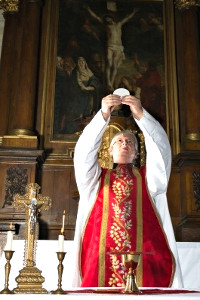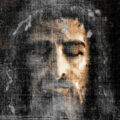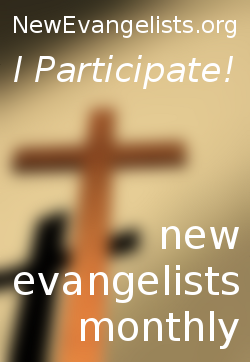
Through the valid celebration of the Most Holy Sacrifice of the Mass, we receive the blessed sacrament — the Eucharist. Blessed are those who have been called to the wedding feast of the Lamb (Revelation 19:9)!
Holy Mother Church teaches us that:
- The Eucharist is literally Jesus Christ: body and blood, soul and divinity.
- The substance of ordinary wheat bread and grape wine (transubstantiate to) become our Lord. Only the appearance (accidents) remain of bread and wine.
- Each of the holy species, body and blood, are all of Jesus. When we receive either, we receive all of Him.
- When the change (transubstantiation) occurs, it is instantaneous. There is no time when the host is “half” Jesus.
- The presence of Christ endures as long as the Eucharistic species subsist.
What is less clear, and as near as I can tell not universally, definitively defined, is the exact moment that transubstantiation occurs. There are opinions offered varying by liturgy, often with compelling reasoning… but authoritative references in support of those positions are lacking.
In the OF Latin rite, it would seem fairly clear that transubstantiation does not occur before the first epiclesis (sometimes called the pre-consecration epiclesis). This is at the beginning of the Eucharistic Prayer where the Holy Spirit is invoked (e.g. EP II: “Make holy therefore, these gifts, we pray, by sending down your Spirit upon them like the dewfall, so that they may become for us the Body + and Blood of our Lord, Jesus Christ.”)
Likewise, it is fairly clear that transubstantiation has occurred after the Eucharistic Prayer when the priest genuflects, elevates the Eucharist and says “Behold the Lamb of God, behold him who takes away the sins of the world. Blessed are those called to the supper of the Lamb.”
A strong case can be made for consecration occurring at the words of institution (“Take this, all of you, and eat of it. For this is my body which will be given up for you.”) The rubrics call for the priest to genuflect at that point, which may arguably be idolatrous otherwise. This appears to be the most common opinion, including mine, of the moment of consecration.
The second most common opinion for the moment of consecration is at the (first) epiclesis itself. It should be noted that the sanctus bells may be rung then as well as at the words of institution.
Here is where it starts to get interesting. While most of us are Latin rite Catholics, we are not the whole of the Catholic Church. 23 churches are in communion with Rome and the liturgies are not the same. They all follow the same pattern: the liturgy of the word, the liturgy of the Eucharist, the sending. This was seen on the road to Emmaus and was practiced in the early, 1st century Church. However, Eastern rite Catholics have not always had, in all cases, the words of institution and some still do not (or are even removing them to restore earlier practice). This may also be true in some non-Catholic cases where Apostolic succession has been maintained and a valid Eucharist is recognized.
One interesting discussion is in the document Guidelines for Admission to the Eucharist Between the Chaldean Church and the Assyrian Church of the East on the Vatican website. Begin reading at section #3 (The Anaphora of Addai and Mari).
Unlike in the Latin rite, even when the words of institution are spoken, Easter rite Catholics and the Orthodox point to the epiclesis if they have to pick a point where consecration occurs. There is value in NOT trying to pinpoint a specific instant but rather recognizing the whole of the Mass (or Divine Liturgy) as the action by which consecration occurs. Zenit says this well:
Concentration on the moment of consecration tends to privilege above all the aspect of the Real Presence, while taking the entire Eucharistic Prayer into account brings out more fully other aspects such as the Eucharist as memorial of Christ’s sacrifice, his resurrection and ascension, the role of the Holy Spirit, the aspect of mediation, its role in building up the Church, etc. In many ways this is the procedure used by the Holy Father in his recent encyclical “Ecclesia de Eucharistia.”
Note too that it is gravely sinful (Can. 927) for a priest to attempt consecration outside of a Mass, for example through the words of institution alone. Similarly, a priest is not permitted to consecrate additional hosts in the same Mass by repeating a portion of it (which would be a non-Mass within the Mass). The Mass and consecration are an integral whole. Attempts to do otherwise are seriously illicit and possibly invalid.
For most of us, this whole topic is simply one of intellectual curiosity. For clergy, extraordinary ministers and sacristans it may have practical implications. Unusual circumstances (e.g. this) may require a proper understanding of the state of consecration. There are many possible extraordinary circumstances. Conservative assumptions in those cases would be most prudent.





















